Inakustik Referenz Cable Base Bedienungsanleitung
- Typ
- Bedienungsanleitung

BEDIEUNGSANLEITUNG | USER MANUAL
REFERENZ CABLE BASE

2
FUNKTIONSWEISE
High End und HiFi Anlagen sind eine Kombination aus hochpräzisen und filigranen Geräten. Perfekt aufeinan-
der abgestimmt vermögen sie Musik in hervorragender Qualität wiederzugeben. Damit die Komponenten je-
doch einwandfrei arbeiten können, müssen sie wie hochpräzise Messinstrumente möglichst frei von Störungen
gehalten werden. Gleiches gilt auch für die Verbindungskabel.
Störungen entstehen jedoch auf vielfältige Art und Weise. Neben den typischen elektromagnetischen Störun-
gen, welche z.B. durch gute Abschirmungen minimiert werden können, beeinflussen auch mechanische Vibra-
tionen und Erschütterungen die Wiedergabequalität.
Dazu kommen insbesondere bei Lautsprecherkabeln noch die Effekte der kapazitiven Kopplung zwischen Lei-
tern und Fußboden. So bilden die Leiter nicht nur zueinander sondern auch zu anderen Flächen in unmittel-
barer Nähe unerwünschte Kapazitäten. Eine gute Maßnahme dagegen ist die Vergrößerung des Abstandes zu
den Flächen. Wenige Zentimeter reichen hier in der Regel schon aus.
Vibrationen entstehen auf verschieden Arten und können durch Körper- oder Luftschall übertragen werden.
Mit dem Körperschall sind die Vibrationen gemeint welche ein Körper, z.B. ein Gerätegehäuse, aufweist. Ein
Beispiel hierfür ist eine Lautsprecherbox. Die Membranen der Box werden gezielt zum Schwingen angeregt. Da
sie aber mit dem Gehäuse der Box mechanisch verbunden sind übertragen sich die Schwingungen auch auf
das Boxengehäuse. Je nach Gehäusegewicht und Bedämpfung sind diese Schwingungen mehr oder weniger
stark ausgeprägt. Sie übertragen sich auch auf die Stellfläche, also auf den Fußboden. Hier passieren nun zwei
Dinge. Zum einen gibt der Fußboden einen Teil der Energie des Körperschalls in Form von Luftschall ab (das
typische Dröhnen entsteht), zum anderen wird der Körperschall z.B. auf das auf dem Fußboden liegende Kabel
übertragen. Zu den Effekten später mehr.
Der Luftschall beschreibt die Schwingungen welche über die Luft übertragen werden und für den Menschen
hörbar sind (Infra- und Ultraschall ausgenommen). Der primäre Zweck einer HiFi- Anlage ist es Schall zu erzeu-
gen. Der Luftschall regt aber nicht nur das Trommelfell an sondern auch alle anderen Flächen die er erreicht.
Auf diesem Wege werden Wände, Fußböden sowie andere Stellflächen und schlussendlich auch die HiFi Kom-
ponenten sowie Kabel zum Schwingen angeregt.
Die Kombination aus Luft- und Körperschall regt also neben den Gläsern in der Vitrine auch alle Komponenten
inklusiver der Kabel einer HiFi Kette mechanisch zum Schwingen an. Untersuchungen zeigen, dass der Klang
der Komponenten und Kabel durch Vibrationen beeinträchtigt wird. Ein Grund dafür sind z.B. Kapazitätswerte
von Bauteilen zueinander welche sich durch die Vibrationen permanent ändern. Um diese sogenannten Mikro-
fonie-Effekten zu minimieren müssen die Komponenten von ihren Stellflächen entkoppelt werden.
Für Geräte und Lautsprecher gibt es hierfür zum Beispiel die Referenz High Tech Gel Absorber. In ihrem Kern ist
ein spezielles Gel welches die Vibrationen physikalisch in Wärme umwandelt.
BEDIENUNGSANLEITUNG REFERENZ CABLE BASE

3
Die Referenz Cable Bases sind speziell für Kabel entwickelt worden. Auch sie haben in ihrem Sockel ein spezi-
elles Gel und zusätzliche Kautschuk-Bänder in denen die Kabel frei schwebend gelagert werden. Neben dem
absorbieren von Vibrationen halten die Referenz Cable Bases das Kabel zusätzlich auf Abstand zum Boden.Das
reduziert unerwünschte Kapazitäten und entlastet die Elektronik.
Die Referenz Cable Bases können flexibel eingesetzt werden. Neben unterschiedlichen Kabeldurchmessern
und Bodenabständen können sie das Kabel offen oder geschlossen lagern:
OFFENE LAGERUNG DER KABEL
Bei dieser Art der Anwendung liegt das Kabel nur locker auf einem Kautschuk-Band und kann in drei unter-
schiedlichen Höhen positioniert werden
KABEL LIEGT AUF DEM BODEN =
HOHE KAPAZITÄT
KABEL HAT EINEN ABSTAND ZUM BODEN =
NIEDRIGE KAPAZITÄT
BEDIENUNGSANLEITUNG REFERENZ CABLE BASE

4
BEDIENUNGSANLEITUNG REFERENZ CABLE BASE
GESCHLOSSENE LAGERUNG DER KABEL
Bei dieser Art der Anwendung wird das Kabel oben und unten durch zwei Kautschuk-Bänder fixiert. Die Vor-
teile liegen darin, dass das Kabel zum Einen bei leichten Bewegungen z.B. beim Ausrichten der Lautsprecher,
nicht von den Bases rutscht und zum Anderen das Kabel in einer definierten Position fixiert ist.
ANWENDUNG
- Mechanische und kapazitive Entkopplung der Lautsprecherkabeln vom Boden
- Mechanische und kapazitive Entkopplung der Chinch- und XLR-Kabeln zu den Stellflächen
- Mechanische und kapazitive Entkopplung von Phono-Kabeln zu den Stellflächen
Ein besonders interessanter Einsatzbereich für die Referenz Cable Bases ist auch das Entkoppeln von Pho-
no-Kabeln da sie sonst unweigerlich Vibrationen an den Tonarm und damit an das sensible Abnehmersystem
übertragen können.
FEATURES
- zur mechanischen und kapazitive Entkopplung von Kabeln
- für Kabeldurchmesser von 10 bis 25mm
- Hightech Gel-Pad im Sockel
- Kautschuk Bänder zur Lagerung der Kabel
- offene oder fixierte Lagerung der Kabel
Bezeichnung: Referenz Cable-Base
Art.-Nr.: 00719223 (Set 10); 00719222 (Set 6)
EAN: 4001985515387 (Set 10); 4001985515394 (Set 6)
10 – 15 mm 15-20 mm 20-25 mm

5
BEDIENUNGSANLEITUNG REFERENZ CABLE BASE

6
OPERATION MANUAL REFERENZ CABLE BASE
FUNCTION
High-end and hi-fi systems are a combination of high-precision and intricately made devices. Perfectly attuned
to each other, they allow music to be played back in outstanding quality. To ensure that all components can
function flawlessly, they need to be kept free of interference to the greatest extent possible, just like high pre-
cision measuring equipment does. The same also applies for the connection cables.
Interference is caused in a number of different ways. Along with typical electromagnetic interference, which
can, for example, be minimised by using good shielding, mechanical vibrations and shocks also have an impact
on the playback quality.
Added to this are the effects of capacitive coupling between conductors and floors, which affect loudspeakers
cables in particular. The conductors form unwanted capacitance, not just in interplay with each other, but also
with other surfaces in the immediate surroundings. A good way to counteract this is by increasing the distance
to the surfaces. As a rule, a few centimetres suffice.
Vibrations are caused in different ways and they can be transmitted by structure-borne and air-borne noise.
Structure-borne noise refers to vibrations that are exhibited by a body, such as the housing of a device. An
example of this is the loudspeaker box. The membranes of the speakers are stimulated, making them vibrate.
However, as the membranes feature a mechanical connection with the loudspeaker housing, they also transfer
vibrations to the housing. The vibrations will be stronger or weaker according to the housing weight and the in-
sulation. The vibrations are also transferred to the surface on which the loudspeakers are placed, this being the
floor. Two things now occur. On the one hand, the floor emits some of the structure-borne energy as airborne
sound (resulting in the typical droning noise), while on the other hand, the structure-borne noise is transferred,
for example, to the cable placed on the floor. More about the effects of this later on.
Airborne sound refers to vibrations that are transferred through the air and that are audible for humans (with
the exception of infrasound and ultrasound). The primary purpose of a hi-fi system is to produce sound. Howe-
ver, airborne noise not only stimulates the eardrum, but also acts on all other surfaces it reaches. This causes
the walls, floors and other surfaces, and ultimately the hi-fi components and cables, to vibrate as well.
The combination of airborne and structure-borne noise not only causes glasses in a display case to vibrate
mechanically, but all components, including the cable used for a hi-fi signal chain, as well. Experiments have
shown that the sound from the components and from the cables is impaired by the vibrations. One reason for
this is, for example, the capacity values of components in relation to each other, which constantly change due
to the vibrations. In order to minimise these so-called microphonic effects, the components must be isolated
from the surface on which they are placed.
This can be done by using the Reference High Tech Gel Absorber, for example, for appliances and loudspeakers.
Their core contains a special gel, which physically converts the vibrations into heat.
BEDIENUNGSANLEITUNG REFERENZ CABLE BASE

7
OPERATION MANUAL REFERENZ CABLE BASE
The Reference Cable Bases have been developed specifically for cables. Their base also contains a special gel,
along with natural rubber strips, in which the cables can float freely. Along with absorbing the vibrations, the
Reference Cable Bases also keep the cables at a distance to the floor. This reduces unwanted capacitances and
reduces the effects on the electronics.
The Reference Cable Bases can be used flexibly. Along with different cable diameters and distances from the
floor, you can also route the cable so that is it open or closed:
OPEN CABLE ROUTING
When routed this way, the cable is only loosely placed on the rubber strip, and can be positioned at three
different heights
CABLE ROUTED ON THE FLOOR =
HIGH CAPACITANCE
CABLE AT A DISTANCE TO THE FLOOR =
LOW CAPACITANCE
BEDIENUNGSANLEITUNG REFERENZ CABLE BASE

8
OPERATION MANUAL REFERENZ CABLE BASE
CLOSED CABLE ROUTING
When routed this way, the cable is fixed in place from above and below by two rubber strips. The advantage is
that the cable, on the one hand, does not slip from the base when exposed to minor movements, for example
when aligning the loudspeaker, while on the other hand, the cable is fixed in a defined position
USE
- Mechanical and capacitive isolation of the loudspeaker cables from the floor
- Mechanical and capacitive isolation of the RCA and XLR cables from the surfaces on which they are placed
- Mechanical and capacitive isolation of phono cables from the surfaces on which they are placed
A particularly interesting way of using the Reference Cable Basis is also for isolating phono cables, as otherwise
they would unavoidably transfer vibrations to the pick-up arm and therefore to the sensitive pick-up system.
FEATURES
- For mechanical and capacitive isolation of cables
- For cable diameters from 10 to 25 mm
- Hi-tech gel pad in the base
- Natural rubber strips for cable routing
- Open or fixed cable routing
Description: Reference Cable Base
Item no.: 00719223 (set 10); 00719222 (set 6)
EAN: 4001985515387 (set 10); 4001985515394 (set 6)
10 – 15 mm 15-20 mm 20-25 mm

9
OPERATION MANUAL REFERENZ CABLE BASE

Wenn Sie mehr über die weiteren Produktbereiche Kabel und Zubehör, AmbienTech, Installation, Musik
& Medien oder HD-BaseT erfahren möchten, lassen wir Ihnen gerne ausführliches Informationsmaterial
zukommen. Außerdem steht Ihnen unser Support-Team Montags bis Donnerstags von 08:00 bis 17:00
und Freitags von 08:00 bis 12:00 unter der Durchwal 07634 5610-70 gerne zur Verfügung. Weitere Infor-
mationen finden Sie auch auf unserer Website www.in-akustik.de.

KABEL
AMBIENTECH
MUSIK & MEDIEN
HDMI-PROFI-INSTALLATION

in-akustik GmbH & Co. KG
Untermatten 12-14
79282 Ballrechten-Dottingen
Germany
Tel.: +49 (0) 7634 5610-70
Fax: +49 (0) 7634 5610-80
E-Mail: [email protected]
Web: www.in-akustik.de
-
 1
1
-
 2
2
-
 3
3
-
 4
4
-
 5
5
-
 6
6
-
 7
7
-
 8
8
-
 9
9
-
 10
10
-
 11
11
-
 12
12
Inakustik Referenz Cable Base Bedienungsanleitung
- Typ
- Bedienungsanleitung
in anderen Sprachen
Verwandte Artikel
-
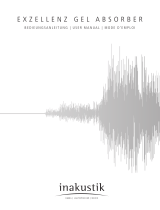 Inakustik Exzellenz Gel Absorber Bedienungsanleitung
Inakustik Exzellenz Gel Absorber Bedienungsanleitung
-
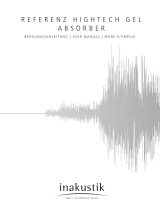 Inakustik Referenz Gel Absorber Bedienungsanleitung
Inakustik Referenz Gel Absorber Bedienungsanleitung
-
Inakustik AmbienTone Slim Bedienungsanleitung
-
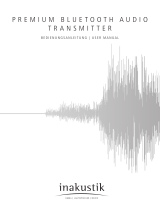 Inakustik Bluetooth Transmitter Bedienungsanleitung
Inakustik Bluetooth Transmitter Bedienungsanleitung
-
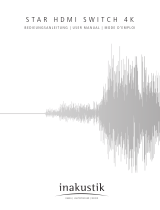 Inakustik Star HDMI Switch 4k Bedienungsanleitung
Inakustik Star HDMI Switch 4k Bedienungsanleitung
-
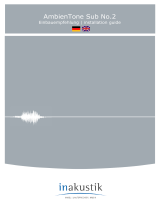 Inakustik AmbienTone Sub 2 Bedienungsanleitung
Inakustik AmbienTone Sub 2 Bedienungsanleitung
-
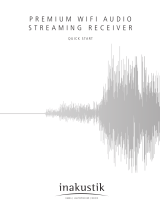 Inakustik WiFi Audio Receiver Bedienungsanleitung
Inakustik WiFi Audio Receiver Bedienungsanleitung
-
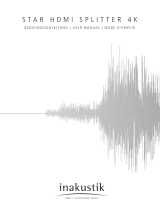 Inakustik Star HDMI Splitter 4K Bedienungsanleitung
Inakustik Star HDMI Splitter 4K Bedienungsanleitung
-
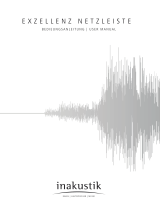 Inakustik Exzellenz Power Bar AC-25.6 Bedienungsanleitung
Inakustik Exzellenz Power Bar AC-25.6 Bedienungsanleitung
-
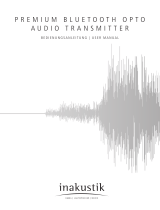 Inakustik Bluetooth Transmitter Bedienungsanleitung
Inakustik Bluetooth Transmitter Bedienungsanleitung




















